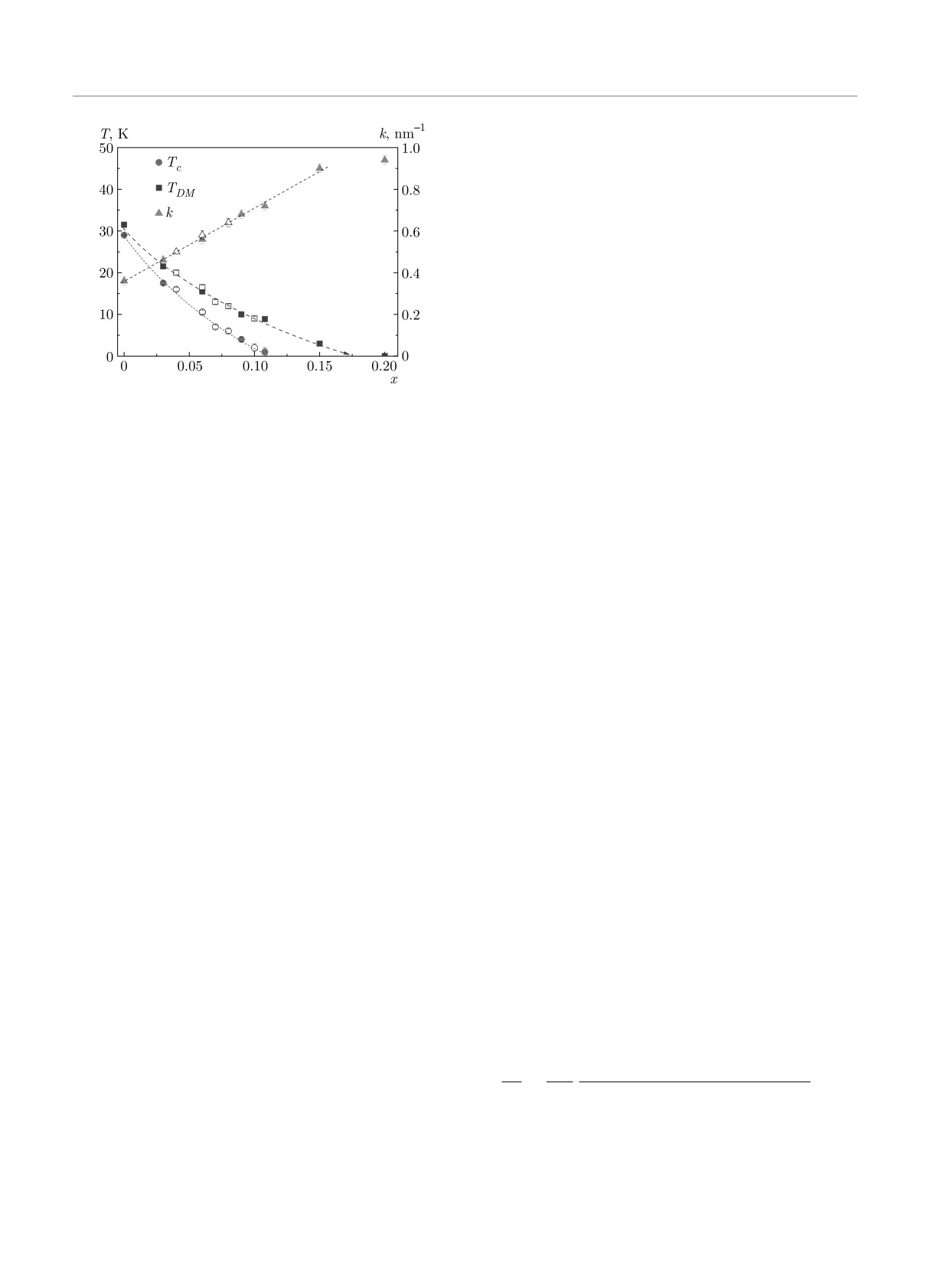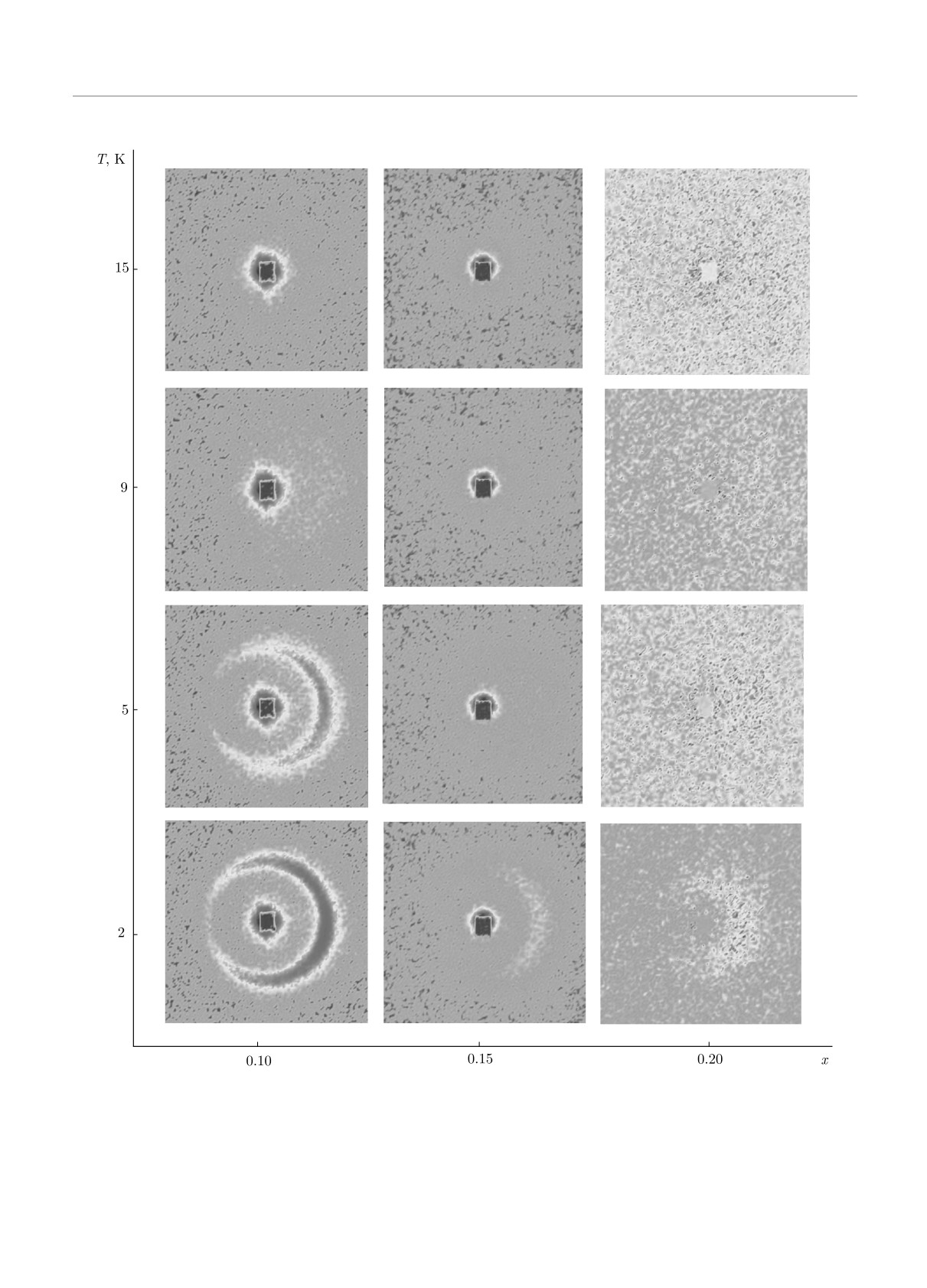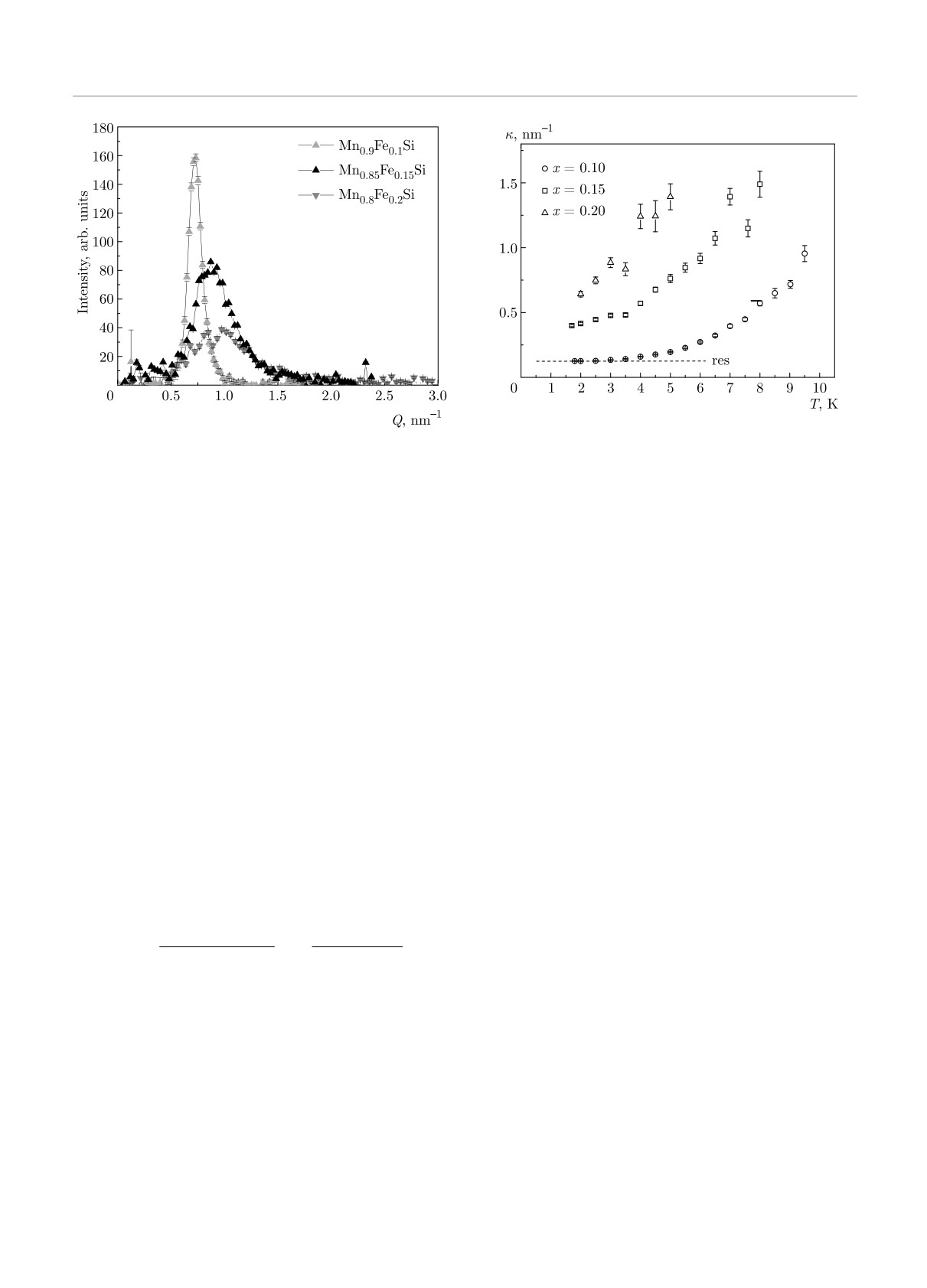ЖЭТФ, 2021, том 159, вып. 4, стр. 690-695
© 2021
CRITICAL FLUCTUATIONS BEYOND THE QUANTUM PHASE
TRANSITION IN DZYALOSHINSKII-MORIYA
HELIMAGNETS Mn1-xFexSi
S. V. Grigorieva,b*, O. I. Utesova,b, N. M. Chubovaa,
C. D. Dewhurstc, D. Menzeld, S. V. Maleyeva
a Petersburg Nuclear Physics Institute named by B. P, Konstantinov of National Reserarch Centre “Kurchatov institute”
188300, Saint Petersburg, Gatchina, Russia
b Saint Petersburg State University
198504, Saint Petersburg, Russia
c Institut Laue-Langevin
38042, Grenoble, Cedex 9, France
d Technische Universität Braunschweig
38106, Braunschweig, Germany
Received December 1, 2020,
revised version December 1, 2020
Accepted for publication December 3, 2020
Contribution for the JETP special issue in honor of I. E. Dzyaloshinskii’s 90th birthday
DOI: 10.31857/S0044451021040106
The isostructural solid solutions Mn1-xFexSi also
reveal intriguing properties upon Fe concentration
growth. The substitution of manganese by iron sup-
Many years have passed since the first observa-
presses the helical order [11]. Neutron scattering stud-
tion of helical spin structures in cubic B20 com-
ies [12, 13] together with magnetic susceptibility and
pounds FeGe [1] and MnSi [2]. However, helimagnets
specific heat measurements [11, 14-16] discovered a
with Dzyaloshinskii-Moriya (DM) interaction [3,4] are
quantum critical point (QCP) described as a suppres-
among the most studied systems in contemporary con-
sion of the spiral phase with long-range order (LRO)
densed matter physics. In particular, this interest is
in Mn1-xFexSi. As it was shown in Refs. [13, 15, 16],
stimulated by rather simple but fancy phase diagram
this QCP located at xc ≈ 0.11-0.12 is hidden by an
which includes topologically lattice (A-phase) [5]. The
extensive phase of spin helix fluctuations. This fluctu-
theoretical descriptions [6,7] pointed out that the com-
ation regime, sometimes referred to as chiral spin liquid
petition between the ferromagnetic exchange interac-
[17, 18], vanishes at about x ≈ 0.24.
tion and the antisymmetric DM interaction is balanced
in the homochiral helical magnetic structure.
Both magnetic susceptibility measurements
Mixed B20 compounds like Mn1-xFexSi or
and neutron scattering experiments demonstrate
Mn1-xFexGe are characterized by additional pa-
a short-range order (SRO) and a crossover to the
rameter x which allows fine tuning for the system
helix fluctuating regime [13, 19-21]. The crossover
properties. In Mn1-xFexGe its variation leads to
temperature TDM decreases with x and becomes
change of the sign of magnetic chirality at xc ≈ 0.75
zero at xDM ≈ 0.17 [12, 22]. It was shown that the
[8, 9], where the system is in ferromagnetic state due
temperature TDM is proportional to the spin wave
to cubic anisotropy [10].
stiffness of the compounds Mn1-xFexSi [23]. One
concludes that these compounds at x ∼ xDM ≈ 0.17
represent the only known example of the system,
* E-mail: grigoryev_sv@pnpi.nrcki.ru
where ferromagnetic exchange approaches zero but
690
ЖЭТФ, том 159, вып. 4, 2021
Critical fluctuations beyond the quantum phase transition. . .
neutrons were detected with a 2D position sensitive
detector. The beam divergence was tuned from 1 to
10 mrad to set the Q-range and Q-resolution optimal
for an individual sample (Q is a momentum transfer).
With these settings, we were able to cover the Q-range
from 2 · 10-2 to 2 nm-1. A weak magnetic field (1 mT)
guiding the polarization P0 was applied along the Qx.
The temperature was set in the range from 1.7 to
60 K with accuracy of the order of 0.05 K. As a result,
we obtain the maps of polarized SANS intensities at
various temperatures for three samples with different
x. A background intensity maps were taken for all
samples at high temperature (T
= 60 K) when no
magnetic scattering is observed. These background
Fig. 1. (Color online) Temperature-concentration (T -x) phase
maps were subtracted from the other scattering maps
diagram of the Mn1-xFexSi compounds and the helix wave
of the given sample. The software GRASP developed
vector k as a function of x. The data taken from several stu-
at the ILL (Grenoble) were used for the primary data
dies [12, 13, 23] are combined with data of the present work.
reduction [24].
The dashed lines are the guides for an eye
Figure 2 shows the maps of the polarized SANS in-
tensities with the polarization along P0. One can fol-
low the evolution of the scattering patterns with tem-
DM interaction is finite and provides chiral rotation of
perature (vertical axis) and the concentration (horizon-
spins in magnetic fluctuations.
tal axis). The whole diagram can be qualitatively de-
In the present paper, we study the critical fluctua-
scribed in the following way. No scattering is observed
tions in DM helimagnets Mn1-xFexSi by means of po-
at the temperature of 15 K for all three concentra-
larized neutron scattering. Three samples with x =
tions. Upon lowering temperature to 9 K, the blurred
= 0.10, x = 0.15, and x = 0.20 are selected so as
but well detectable scattering appears for the sample
to represent three different regimes: namely close to
with x = 0.10, while the samples with x = 0.15 and
the quantum critical point x ∼ xc, close to the con-
x = 0.20 show no scattering, demonstrating absence
centration with zero ferromagnetic exchange xDM , and
of short-range magnetic correlations. Further temper-
beyond this concentration, respectively.
ature lowering to 5 K forms a well-defined “half-moon”
The series of Mn1-xFexSi single crystals with x =
image (which is typical for chiral helimagnets) for the
= 0.10, 0.15, 0.20 were grown using the Czochralski
sample with x = 0.10. For the ones with x = 0.15 and
technique at the Institute of Condensed Matter Physics
x = 0.20, it results in the appearance of the blurred im-
(Braunschweig, Germany). These samples were pre-
ages. At T = 2 K, the scattering for the sample with
pared as cylinders with a height of 15-20 mm and a
x = 0.10 is almost the same, whereas for the sample
diameter of 5-6 mm.
with x = 0.15, a slightly blurred half-moon image ap-
The temperature-concentration (T -x) phase dia-
pears. For the most disordered sample with x = 0.20,
gram is shown in Fig. 1. One can see (in accord with
the image is still far from being well-defined half-moon.
Refs. [13, 15, 16, 19]) that Tc, which indicates a phase
We note that the scattering is strongly asymmetric in
with LRO, reaches zero at xc ≈ 0.11-0.12, while the
all cases. The latter is typical for the critical scattering
temperature band of the fluctuating helix regime in-
above Tc in the MnSi system [20,21,25].
creases with x. The decrease in Tc is accompanied by
Similarly to Ref. [26], we treated the obtained data
the linear with x increase in the helix wave vector k, as
using the following mean-field form of the neutron cross
shown in Fig. 1.
section which is appropriate for the disordered fluctu-
The polarized small-angle neutron scattering
ating phase in these compounds (T > Tc) [20, 25]:
(SANS) was performed using the D22 instrument at
dσ
r2T k2 + κ2 + Q2 + 2 sgn(D) kQ · P0
the Laue-Langevin Institute (Grenoble, France). The
=
[
][
] .
(1)
dΩ
[110] axis of the single crystal was oriented parallel to
A (Q + k)2 + κ2 (Q - k)2 + κ2
the neutron beam with an accuracy of 5◦. A polarized
neutron beam with initial polarization P0 = 0.93 and
Here Q is the scattering vector, r is the classical elect-
mean wavelength λ = 0.60 nm was used. The scattered
ron radius, κ is the inverse correlation length of the
691
8*
S. V. Grigoriev, O. I. Utesov, N. M. Chubova et al.
ЖЭТФ, том 159, вып. 4, 2021
Fig. 2. (Color online) Maps of the polarized SANS intensities plotted on the T -x phase diagram for Mn1-xFexSi system for the
polarization P0 along the guide field
692
ЖЭТФ, том 159, вып. 4, 2021
Critical fluctuations beyond the quantum phase transition. . .
Fig. 4. Temperature dependence of the inverse correlation
Fig. 3. (Color online) Q-dependence of the azimuthally ave-
length of helical fluctuations for the Mn1-xFexSi system with
raged scattering intensity for the Mn1-xFexSi system with
x = 0.10, 0.15, 0.20 in the log-log scale (the line denoted “res”
x = 0.10, 0.15, 0.20 at T = 2.0 K
shows the level of the instrumantal resolution)
critical fluctuation, A is the spin wave stiffness at low
can be ascribed to the scattering on the critical fluc-
temperatures, D is the Dzyaloshinskii constant, and
tuations of the helical structure, whereas at low tem-
P0 is the incident polarization of neutrons. The cross
peratures, I(Q) is described by the sum of the Gaus-
section (Eq. (1)) has several features provided by DM
sian and Lorentzian for the samples with x = 0.10 and
interaction.
x = 0.15; Gaussian term being attributed to the limi-
(i) Due to the second term of the product in the
tation of the instrument resolution, which exceeds the
denominator, the scattering intensity should form a
value of 0.12 nm-1 (see Fig. 3, curve for x = 0.10).
sphere of radius Q = k with a width of κ. The scalar
variables in (Q - k)2 are due to isotropic DM interac-
The whole set of the experimental data obtained
tion.
by polarized SANS was fitted to Eq. (1). The position
(ii) The intensity has the Lorentzian shape typical
of the maximum k (the helix wavevector) and inverse
for critical fluctuations.
correlation length κ of the helix were obtained as a re-
(iii) The scattering intensity is strongly oriented
sult of the fit. The wave vector does not change with
along the incident neutron polarization since the nu-
the temperature within the error bars for the individ-
merator of Eq. (1) is maximal at P0 parallel to Q and
ual sample. It is equal to 0.72 nm-1, 0.90 nm-1, and
it is minimal at P0 antiparallel to Q.
0.94 nm-1 for the samples with x = 0.10, 0.15, and
The chirality of the critical fluctuations can be esti-
0.20, respectively. Interesting to note that the wave
mated via measurement of the polarization of the scat-
vector changes linearly with the concentration in the
tering:
range of x = 0-0.15 and saturates at the concentration
x larger that 0.15 (see Fig. 1). It is correlated to the
σ(P0) - σ(-P0)
2kQP0 cosφ
range with the finite crossover temperature TDM in the
Ps(Q) =
=-
,
(2)
σ(P0) + σ(-P0)
Q2 + k2 + κ2
Mn1-xFexSi compounds.
where φ is the angle between P0 and Q, and we use
The temperature dependence of the inverse corre-
Eq. (1) to express its value via parameters Q, k and κ.
lation length κ is shown in Fig. 4. As it was noticed
For quantitative analysis, the intensity maps were
above, the value of κ is resolution limited for the com-
azimuthally averaged. Examples of the radial pro-
pound with x = 0.10 for the low temperature range.
files (the Q-dependence of the scattering intensity) are
It saturates with lowering temperature at Tc = 3.0 K
shown in Fig. 3. As it is well seen in Fig. 3, the position
(x = 0.10). In contrast, for the sample with x = 0.15,
and the width of the observed peak differ for the three
κ tends to saturate at larger value, disorder-induced κd
samples. The scattering curve I(Q) can be well de-
(see below). For the sample with x = 0.20, κ does not
scribed by the Lorentzian at high temperatures, which
saturate at all.
693
S. V. Grigoriev, O. I. Utesov, N. M. Chubova et al.
ЖЭТФ, том 159, вып. 4, 2021
We observe (it was also noted in Refs. [20,25]) that
In the considered mixed B20 helimagnet, the LRO
the polarization Ps (Q = k) is close to 1 at low tempera-
disappears at xc ≈ 0.11. The correlation length ξd
ture even for the most disordered sample with x = 0.20,
decreases from infinity at xc to finite values at larger
which shows that DM interaction is still present and
Fe concentrations. We denote disorder-induced inverse
makes short fluctuations chiral. Upon increase of tem-
correlation length as κd. When discussing polarized
perature, the polarization Ps was found to decrease
neutron scattering data, κ2d should be added into the
smoothly.
denominator of Eq. (1) and considered as a part of κ2
The behaviour observed experimentally can be
along with temperature-dependent contribution κ2T as
qualitatively understood using the assumption that Fe
the system has effective size ξd [32].
ions introduce the defect antiferromagnetic (AF) bonds
Thus, we arrive to the following qualitative picture.
in the system. First of all, strong AF bonds lead to
The sample with x = 0.10 has κd = 0 and behaves
significant lowering of the spin wave stiffness, Tc, and
like pure MnSi with lower Tc and TDM values due to
TDM . The latter becomes zero at x = xDM . Moreover,
AF bonds-induced lowering of the spin-wave stiffness.
according to the theory of Ref. [27], strong AF bonds
Half-moon patterns and sharp peaks in the neutron
can lead to large variation of the helical vector even at
scattering (see Figs. 2 and 3), and peaks in magnetic
small concentrations (see Fig. 1).
susceptibility [22] near Tc are well pronounced due to
It is well-known that the strong frustrating defect
mean-field denominator propotional to (Q - k)2 + κ2T .
bonds with finite concentration destroy the long-range
For the sample with x = 0.15, the inverse corre-
order in the two-dimensional collinear magnets. In-
lation lenght κd is nonzero and it is smaller than k.
stead, the SRO order of the glassy phase emerges in
It leads to the highly chiral fluctuating phase at T <
the system [28, 29]. Strong defects lead to additional
< TDM, but suppresses the growth of the critical fluc-
rotations of spins, δϕ(r), in the classical ground state
tuations so naturally seen at x < xc. Moreover, since
of the system. For a single defect bond, they can be
κ has a tendency to saturation upon temperature low-
described as the dipolar field (cf. Refs. [27, 30]),
ering (see Fig. 4), apparently there should be a transi-
d·r
tion to frozen SRO phase (like in usual spin-glasses, see
δϕ(r) =
,
(3)
rD
Ref. [33]) with correlation length larger than the spi-
ral period. In the polarized neutron images, such be-
where d is the dipole moment of the defect bond, r
haviour results in blurred half-moon patterns, whereas
is the distance from the defect bond, and D is the di-
in magnetic susceptibility measurements [22] there is a
mension of the system. After averaging over disorder
broad maximum.
configurations, one gets for mean squared transverse
At x = xDM , spin wave stiffness becomes zero, and
fluctuation of the ordered moment M [31]:
a possible qualitative description of the experimental
∫
data observed at x > xDM (e. g., blurred SANS maps
〈M2⊥〉 ∼ xM2 dDr δϕ2(r).
(4)
and negative Curie-Weiss temperature) can be based
on a domination of the AF interaction in the sample.
In two-dimensional systems, this integral diverges as
Concentration xDM itself is very peculiar, its vicinity
a logarithm on large distances and the cut-off (disor-
in T -x phase diagram should reveal intriguing proper-
der-induced correlation length ξd) should be intro-
ties of the fluctuating highly chiral helical state with
duced. Importantly, ξd is finite for every nonzero con-
the shortest period possible for such systems. The cor-
centration x. In three-dimensional systems, the same
relation length of these fluctuations are affected by two
scenario can occur at finite concentrations xc if the dis-
factors not related to temperature: disorder induced
order is strong enough [29]. Correlation length can be
by the AF bonds and DM interaction destabilizing
estimated using the condition
the ferromagnetic order. A detailed description of the
∫ξd
situation in the vicinity of xDM requires further exper-
1 = x d3r δϕ2(r),
(5)
imental studies.
which at x > xc yields
Funding. The authors thank for the support the
Russian Science Foundation (grant No. 17-12-01050).
ξd ∼ (x - xc)-1.
(6)
Note, that the correlation length ξd is temperature-
The full text of this paper is published in the English
independent since its nature is pure classical.
version of JETP.
694
ЖЭТФ, том 159, вып. 4, 2021
Critical fluctuations beyond the quantum phase transition. . .
REFERENCES
18.
F. Kruger, U. Karahasanovic, and A. G. Green, Phys.
Rev. Lett. 108, 067003 (2012).
1.
L. Lundgren, O. Beckman, V. Attia, S. P. Bhattache-
rjee, and M. Richardson, Phys. Scripta 1, 69 (1970).
19.
V. V. Glushkov, I. I. Lobanova, V. Yu. Ivanov,
V. V. Voronov, V. A. Dyadkin, N. M. Chubova,
2.
Y. Ishikawa, K. Tajima, D. Bloch, and M. Roth, Sol.
S. V. Grigoriev, and S. V. Demishev, Phys. Rev. Lett.
St. Comm. 19, 525 (1976).
115, 256601 (2015).
3.
I. Dzyaloshinskii, J. Phys. Chem. Sol. 4, 241 (1958).
20.
S. V. Grigoriev, S. V. Maleyev, E. V. Moskvin,
4.
T. Moriya, Phys. Rev. 120, 91 (1960).
V. A. Dyadkin, P. Fouquet, and H. Eckerlebe, Phys.
Rev. B 81, 144413 (2010).
5.
S. Muhlbauer, B. Binz, F. Jonietz, C. Pfleiderer,
A. Rosch, A. Neubauer, R. Georgii, and P. Böni, Sci-
21.
M. Janoschek, M. Garst, A. Bauer, P. Krautscheid,
ence 323, 915 (2009).
R. Georgii, P. Böni, and C. Pfleiderer, Phys. Rev.
B 87, 134407 (2013).
6.
O. Nakanishia, A. Yanase, A. Hasegawa, and M. Ka-
taoka, Sol. St. Comm. 35, 995 (1980).
22.
L. J. Bannenberg, F. Weber, A. J. E. Lefering,
T. Wolf, and C. Pappas, Phys. Rev. B 98, 184430
7.
P. Bak and M. H. Jensen, J. Phys. C 13, L881 (1980).
(2018).
8.
S. V. Grigoriev, N. M. Potapova, S.-A. Siegfried,
V. A. Dyadkin, E. V. Moskvin, V. Dmitriev, D. Men-
23.
S. V. Grigoriev, E. V. Altynbaev, S.-A. Siegfried,
K. A. Pschenichnyi, D. Menzel, A. Heinemann, and
zel, C. D. Dewhurst, D. Chernyshov, R. A. Sadykov,
L. N. Fomicheva, and A. V. Tsvyashchenko, Phys.
G. Chaboussant, Phys. Rev. B 97, 024409 (2018).
Rev. Lett. 110, 207201 (2013).
24.
The data reduction software used is Graph-
9.
K. Shibata, X. Z. Yu, T. Hara, D. Morikawa, N. Ka-
ical Reduction and Analysis SANS Program
nazawa, K. Kimoto, S. Ishiwata, Y. Matsui, and
Y. Tokura, Nature Nanotechnology 8, 723 (2013).
ments-groups/groups/lss/grasp/.
10.
S. V. Grigoriev, A. S. Sukhanov, and S. V. Maleyev,
25.
S. V. Grigoriev, S. V. Maleyev, A. I. Okorokov,
Phys. Rev. B 91, 224429 (2015).
Y. O. Chetverikov, R. Georgii, P. Böni, D. Lama-
go, H. Eckerlebe, and K. Pranzas, Phys. Rev. B 72,
11.
Y. Nishihara, S. Waki, and S. Ogawa, Phys. Rev.
134420 (2005).
B 30, 32 (1984).
26.
N. M. Chubova, E. V. Moskvin, V. A. Dyad’kin,
12.
S. V. Grigoriev, V. A. Dyadkin, E. V. Moskvin, D. La-
Ch. Dewhurst, S. V. Maleev, and S. V. Grigor’ev,
mago, Th. Wolf, H. Eckerlebe, and S. V. Maleyev,
JETP 125, 789 (2017).
Phys. Rev. B 79, 144417 (2009).
13.
S. V. Grigoriev, E. V. Moskvin, V. A. Dyadkin,
27.
O. I. Utesov, A. V. Sizanov, and A. V. Syromyat-
nikov, Phys. Rev. B 92, 125110 (2015).
D. Lamago, T. Wolf, H. Eckerlebe, and S. V. Maleyev,
Phys. Rev. B 83, 224411 (2011).
28.
A. Aharony, R. J. Birgeneau, A. Coniglio,
14.
S. V. Demishev, I. I. Lobanova, V. V. Glushkov,
M. A. Kastner, and H. E. Stanley, Phys. Rev. Lett.
T. V. Ischenko, N. E. Sluchanko, V. A. Dyadkin,
60, 1330 (1988).
N. M. Potapova, and S. V. Grigoriev, JETP Lett.
29.
V. Cherepanov, I. Y. Korenblit, A. Aharony, and
98, 829 (2013).
O. Entin-Wohlman, Eur. Phys. J. B 8, 511 (1999).
15.
A. Bauer, A. Neubauer, C. Franz, W. Munzer,
M. Garst, and C. Pfleiderer, Phys. Rev. B 82, 064404
30.
I. Ya. Korenblit, Phys. Rev. B 51, 12551 (1995).
(2010).
31.
S. Dey, E. C. Andrade, and M. Vojta, Phys. Rev.
16.
S. V. Demishev, V. V. Glushkov, S. V. Grigoriev,
B 101, 020411(R) (2020).
M. I. Gilmanov, I. I. Lobanova, A. N. Samarin,
A. V. Semeno, and N. E. Sluchanko, Phys.-Uspekhi
32.
A. Z. Patashinskii and V. L. Pokrovskii, Fluctuation
59, 559 (2016).
Theory of Phase Transitions, Pergamon Press (1979).
17.
S. Tewari, D. Belitz, and T. R. Kirkpatrick, Phys.
33.
S. L. Ginzburg, Irreversible Phenomena of Spin Glas-
Rev. Lett. 96, 047207 (2006).
ses (in Russian), Nauka, Moscow (1989).
695





